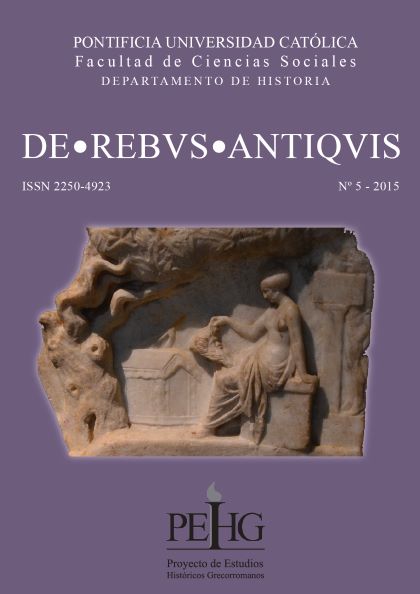The doble image of Augustus’ morality
Keywords:
Augustus, adultery, Antonius, vice, virtueAbstract
Augustus came to power by being the adoptive son of Caesar. Up to receive the title of Augustus in the year 27 BC, he was known as G. Iulius Caesar Diui filius. Being the heir of Caesar had to be more to receive his name and his powers: their personal qualities should also remember the dictator. For this reason, during half of the triumvirate, Augusto tried to emulate his adoptive father in his qualities as a lover. His tumultuous, emotional and marital life is concentrated among 44 and 35 BC, with several marriages or betrothal, and the birth of his only daughter. From this period come the stories that, one and a half centuries later, would transmit Suetonius (from an unknown, close to Antonius, source). From the sacred Holiness enacted to Livia in year 35 BC, however, begins a new stage in the moral image of Augustus, focused on virtue and monogamy: a stage that would lead him years later to banish his own daughter and, later, his granddaughter, for adultery. This double image of Augustus, the first due to the emulation of his adoptive father, and the second due to a need for ideological justification of his regime against his enemy Mark Antony, come from the seemingly contradictory news on “private vices and public virtues” of Augustus.
Downloads
References
BIBLIOGRAFÍA CITADA
AGUDO, R. M. (1992). Suetonio, Vidas de los doce Césares. Madrid.
BALSDON, J. P. V. D. (1962). Roman women. Their history and habits. Londres. BARRETT, A. A. (2004). Livia. Primera dama de la Roma imperial. Madrid.
BENEKER, J. (2003). No time for love: Plutarch's chaste Caesar. Greek, Roman and Byzantine Studies, 43, pp. 13-29.
CLASSEN, C. J. (1991). Virtutes imperatoriae. Arctos, 25, pp. 17-39.
EVERITT, A. (2008). Augusto. El primer emperador. Barcelona.
FRASCHETTI, A. (2001). Livia the politician. En: Fraschetti, A. (Ed.). Roman women. Chicago, pp.100-117.
HIROSE, M. (1996). Reconsideration of Livia, wife of the first roman emperor Augustus with the special references to the portraits of Livia. Journal of Classical Studies, 44, pp. 109-120.
POSADAS, J. L. (2012). Mujeres en la literatura latina: de César a Floro. Madrid.
--- (2011). Los emperadores romanos y el sexo. Madrid.
--- (2009). La integración de las mujeres en la política republicana: de Sempronia a Octavia. En Bravo Castañeda, G. - González Salinero, R. (Eds.). Formas de integración en el mundo roman. Madrid, pp. 237-248.
--- (2008). Emperatrices y princesas de Roma. Madrid.
ROLDÁN, J. M. (2008). Césares. Madrid.
SIMPSON, Ch. J. (1998). Imp. Caesar Diui filius: his second imperatorial acclamation and the evolution of an allegedly exorbitant name. Athenaeum, 86, pp. 419-437.
VIRLOUVET, C. (2001). Fulvia, the woman of passion. En Fraschetti, A. (Ed.). Roman women. Chicago, pp. 66-81.
WINKES, R. (2000). Livia. Portrait and propaganda. En Kleiner, D. E. E. – Matheson, S. B. Claudia II. Women in roman art and society. Austin, pp. 29-42.
Downloads
Published
How to Cite
Issue
Section
License










